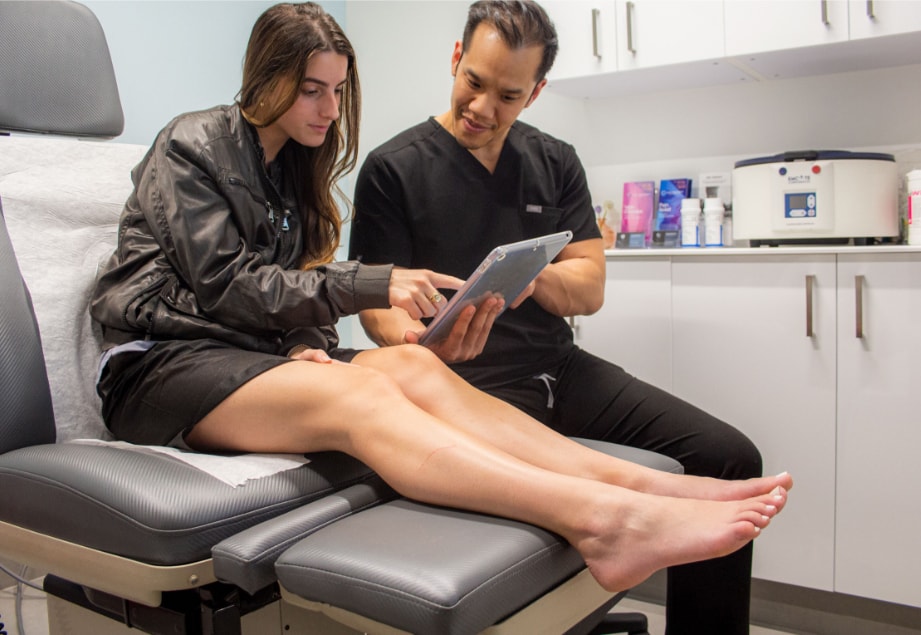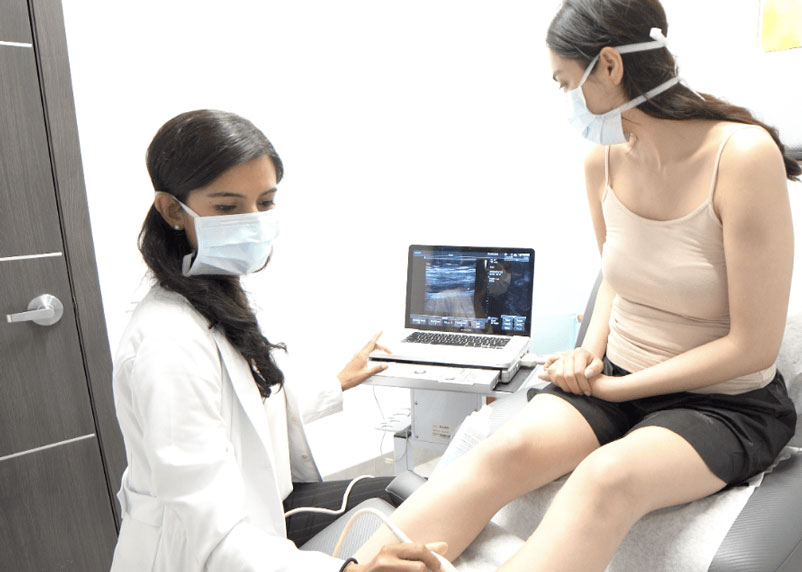Spider vein injections produce permanent results
Sclerotherapy is a minimally-invasive vein treatment to remove spider veins and small varicose veins. The procedure involves injecting a sclerotherapy solution into the veins, which causes them to shrink, turn into hardened scar tissues, and eventually get metabolized by the body, following which they fade away from the skin’s surface. Sclerotherapy is the most popular treatment for spider veins. The results of sclerotherapy are usually permanent, but you may develop new spider veins over time.

The lasting effects of sclerotherapy will depend on the size and location of the treated veins. For example, larger veins or veins in difficult-to-treat areas may require multiple sclerotherapy treatments. The longevity of the results also depends on whether you have underlying chronic venous insufficiency, the root cause of all vein problems, and whether your vein doctor treats underlying vein disease before removing spider veins. While the same spider veins can’t return, it’s possible to get new spider veins over time.
Vein Treatment Clinic is known for ensuring long-lasting results from sclerotherapy spider vein treatments. Our vein doctors always administer ultrasound diagnostic tests to evaluate the root cause of spider veins, determine if you have vein disease, and curate a personalized treatment plan. Instead of simply removing the visible spider veins, we identify and treat the root cause of your vein problems to ensure long-lasting results and minimize the risk of recurrence. Our considered approach to spider vein treatment helps us maintain a perfect track record.

You can find our vein treatment clinics in New York City, Long Island, California, Maryland, and New Jersey. If you’re in New Jersey, you can find our state-of-the-art vein treatment clinics in Clifton, Woodland Park, and Paramus. Our Clifton vein treatment clinic is just past the Ford dealership on route 46-E, extremely close to the garden state parkway. Please schedule an appointment to explore your spider vein treatment options.
But there’s a catch: vein injections can’t prevent new spider veins from appearing
Vein injections, also called sclerotherapy, are a tried-and-true method for getting rid of spider veins. A sclerotherapy solution is injected into the veins, causing them to collapse and eventually disappear. In most cases, the treated veins will disappear within a few weeks, though larger veins may take longer to resolve. Once the injected veins have disappeared, they can never come back. But new spider veins may appear in other areas, especially if you haven’t undergone treatment for the root cause of spider veins — chronic venous insufficiency.
Another catch: vein injections can’t treat the root cause of varicose veins and spider veins
Sclerotherapy is one of the most effective treatments for spider veins. But sclerotherapy is considered to be a cosmetic treatment because it can’t treat the root cause of spider veins — only the visible symptoms.
Chronic venous insufficiency is the primary root cause of spider veins, varicose veins, and most other vein problems. Venous insufficiency is a medical condition wherein the collapse of vein valves leads to backward blood circulation and the accumulation of blood in leg veins. The continued accumulation of blood in leg veins leads to vascular dilation and the eventual formation of spider veins and varicose veins. Some of the other symptoms of vein disease include leg heaviness, restless leg syndrome, frequent leg cramps, and leg swelling.
Sclerotherapy can only close the veins located close to the skin’s surface — spider veins. Each sclerotherapy injection effectively closes and collapses one spider vein. But it can’t penetrate into the deep saphenous vein and treat chronic venous insufficiency. Treating spider veins without addressing the root cause is like painting over a stained wall instead of fixing the leaky pipes underneath. As long as the leak exists, new stains and spider veins will reappear. That’s why comprehensive vein treatment is essential.
So, what’s the most effective way to eliminate varicose veins and spider veins for good?
There are no definitive means of eliminating varicose veins and spider veins for good. Even after comprehensive vein treatments, there’s a possibility that you may develop new spider veins and varicose veins when new vein valves are damaged. But you can minimize the risk of spider veins and varicose veins with comprehensive treatments for chronic venous insufficiency.
Our vein doctors always diagnose and treat the root cause of your vein problems — not just the symptoms. They perform ultrasound diagnostic tests to determine if your vein problems are caused by underlying vein disease. If so, they curate a personalized vein treatment plan consisting of minimally invasive procedures that collapse the diseased saphenous vein, restore optimal blood circulation to the heart, and then remove the superficial varicose veins and spider veins,
The following are the most effective treatments for vein disease:
- Radiofrequency Ablation: RFA uses heat to collapse the veins and seal them shut.
- Endovenous Laser Ablation: EVLA uses laser energy to destroy the diseased saphenous veins responsible for your vein problems.
- VenaSeal: Venaseal uses a medical adhesive to seal the veins shut, turning them into hardened scar tissues eventually reabsorbed by the body.
Furthermore, after your vein treatment, you must make lifestyle changes that ensure optimal blood circulation in your legs. The following lifestyle changes can minimize the risk of vein disease recurrence:
- Wear compression stockings
- Elevate your legs while sitting down
- Don’t sit or stand still for long periods
- Drink lots of water
- Engage in regular exercise — running, swimming, cycling, and yoga









